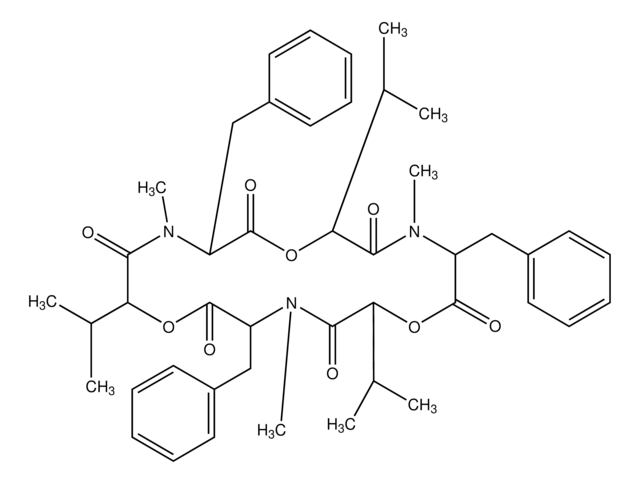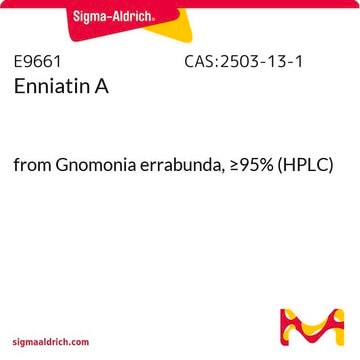D4921
Destruxin A from Metarrhizium anisopliae
≥98% (HPLC)
Sélectionner une taille de conditionnement
1 200,00 $
Sélectionner une taille de conditionnement
About This Item
1 200,00 $
Produits recommandés
Source biologique
Metarrhizium anisopliae
Niveau de qualité
Essai
≥98% (HPLC)
Forme
powder
Température de stockage
−20°C
Chaîne SMILES
CC[C@H](C)[C@@H]1NC(=O)[C@H]2CCCN2C(=O)[C@H](CC=C)OC(=O)CCNC(=O)[C@H](C)N(C)C(=O)[C@H](C(C)C)N(C)C1=O
InChI
1S/C29H47N5O7/c1-9-12-21-27(38)34-16-11-13-20(34)26(37)31-23(18(5)10-2)28(39)33(8)24(17(3)4)29(40)32(7)19(6)25(36)30-15-14-22(35)41-21/h9,17-21,23-24H,1,10-16H2,2-8H3,(H,30,36)(H,31,37)/t18-,19-,20+,21-,23-,24-/m0/s1
Clé InChI
XIYSEKITPHTMJT-UTJJDKHZSA-N
Application
Actions biochimiques/physiologiques
Qualité
Mention d'avertissement
Warning
Mentions de danger
Classification des risques
Acute Tox. 4 Dermal - Acute Tox. 4 Inhalation - Acute Tox. 4 Oral - Eye Irrit. 2 - Skin Irrit. 2 - STOT SE 3
Organes cibles
Respiratory system
Code de la classe de stockage
11 - Combustible Solids
Classe de danger pour l'eau (WGK)
WGK 3
Point d'éclair (°F)
Not applicable
Point d'éclair (°C)
Not applicable
Équipement de protection individuelle
dust mask type N95 (US), Eyeshields, Gloves
Faites votre choix parmi les versions les plus récentes :
Certificats d'analyse (COA)
Vous ne trouvez pas la bonne version ?
Si vous avez besoin d'une version particulière, vous pouvez rechercher un certificat spécifique par le numéro de lot.
Déjà en possession de ce produit ?
Retrouvez la documentation relative aux produits que vous avez récemment achetés dans la Bibliothèque de documents.
Active Filters
Notre équipe de scientifiques dispose d'une expérience dans tous les secteurs de la recherche, notamment en sciences de la vie, science des matériaux, synthèse chimique, chromatographie, analyse et dans de nombreux autres domaines..
Contacter notre Service technique








